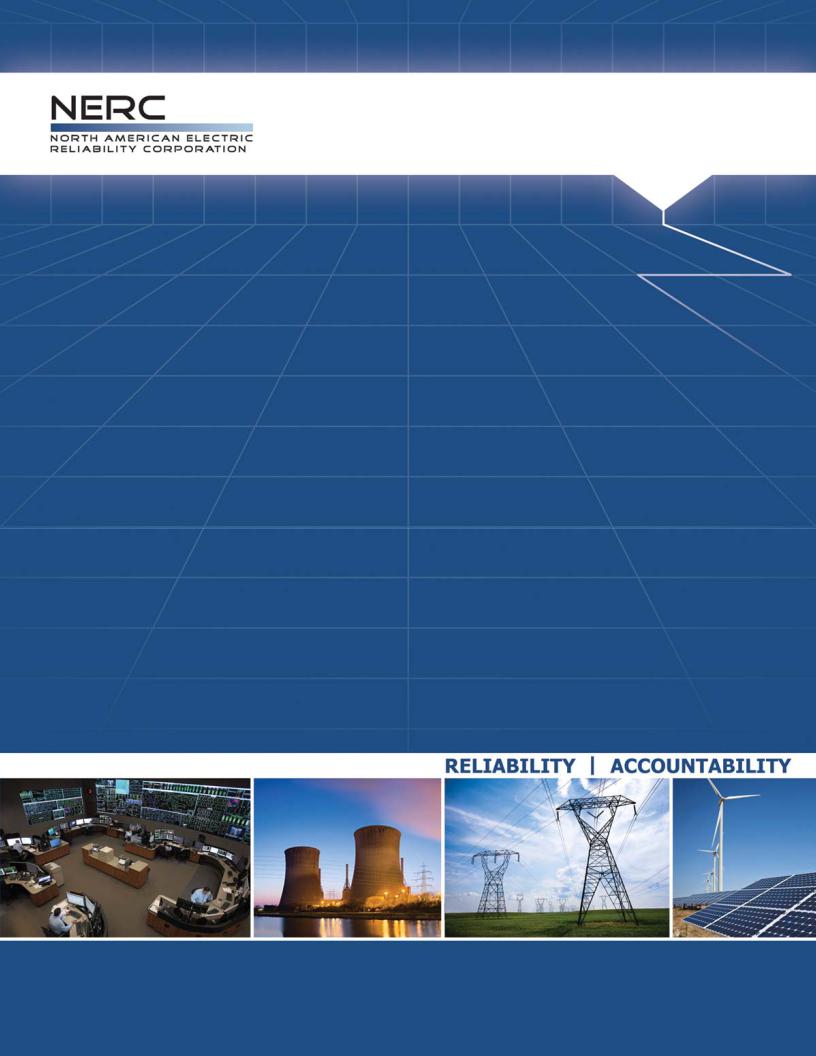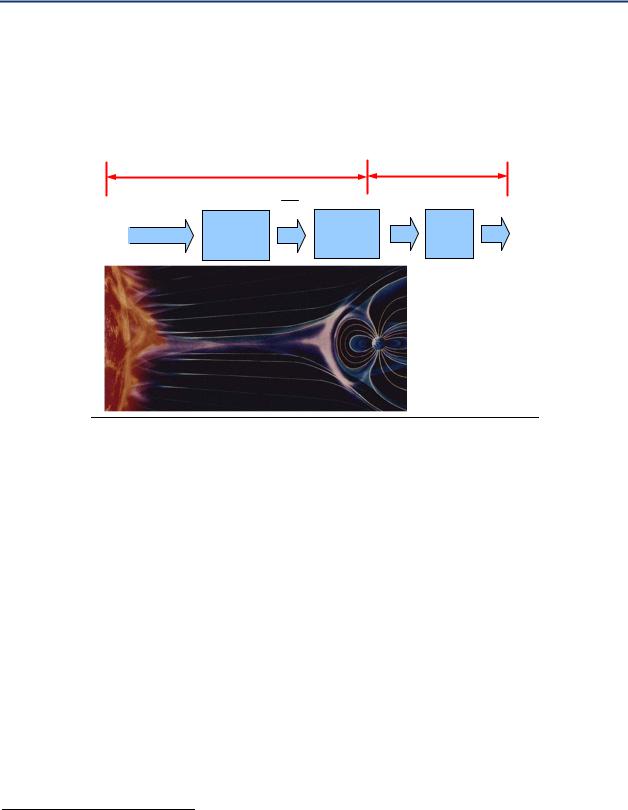
Geomagnetic_Disturbance_Task_Force_2012
.pdf
2012 Special Reliability Assessment Interim Report:
Effects of Geomagnetic Disturbances on the Bulk Power System
February 2012

This page intentionally left blank

Preface
Preface
The North American Electric Reliability Corporation (NERC) has prepared the following assessment in accordance with the Energy Policy Act of 2005, in which the United States Congress directed NERC to conduct periodic assessments of the reliability and adequacy of the bulk power system of North America.1,2 NERC operates under similar obligations in many Canadian provinces, as well as a portion of Baja California Norte, México.
NERC Mission
The North American Electric Reliability Corporation (NERC) is an international regulatory authority established to evaluate reliability of the bulk power system in North America. NERC develops and enforces reliability standards; assesses reliability annually via a 10 year assessment, and winter and summer seasonal assessments; monitors the bulk power system; and educates, trains, and certifies industry personnel. NERC is the Electric Reliability Organization for North America, subject to oversight by the U.S. Federal Energy Regulatory Commission (FERC) and governmental authorities in Canada.3
Figure A: NERC Regional Entities |
Table A: NERC Regional Entities |
|
|
|
|
|
FRCC |
Florida Reliability Coordinating Council |
|
MRO |
Midwest Reliability Organization |
|
NPCC |
Northeast Power Coordinating Council |
|
RFC |
ReliabilityFirst Corporation |
|
SERC |
SERC Reliability Corporation |
|
SPP |
Southwest Power Pool Regional Entity |
|
TRE |
Texas Reliability Entity |
|
WECC |
Western Electricity Coordinating Council |
|
|
|
Note: The highlighted area between SPP and SERC denotes overlapping Regional area boundaries.
NERC assesses and reports on the reliability and adequacy of the North American bulk power system, which is divided into eight regional areas, as shown in the map (Figure A) and corresponding table (Table A). The users, owners, and operators of the bulk power system within these areas account for virtually all the electricity supplied in the United States, Canada, and a portion of Baja California Norte, México.
1H.R. 6 as approved by of the One Hundred Ninth Congress of the United States, the Energy Policy Act of 2005: http://www.gpo.gov/fdsys/pkg/BILLS 109hr6enr/pdf/BILLS 109hr6enr.pdf
2The NERC Rules of Procedure, Section 800, further detail the Objectives, Scope, Data and Information requirements, and Reliability Assessment Process requiring annual seasonal and long term reliability assessments.
3As of June 18, 2007, the U.S. Federal Energy Regulatory Commission (FERC) granted NERC the legal authority to enforce Reliability Standards with all U.S. users, owners, and operators of the bulk power system, and made compliance with those standards mandatory and enforceable. In Canada, NERC presently has memorandums of understanding in place with provincial authorities in Ontario, New Brunswick, Nova Scotia, Québec, and Saskatchewan, and with the Canadian National Energy Board. NERC standards are mandatory and enforceable in British Columbia, Ontario, New Brunswick, and Nova Scotia. NERC has an agreement with Manitoba Hydro making reliability standards mandatory for that entity, and Manitoba has adopted legislation setting out a framework for standards to become mandatory for users, owners, and operators in the province. In addition, NERC has been designated as the “electric reliability organization” under Alberta’s Transportation Regulation, and certain reliability standards have been approved in that jurisdiction; others are pending. NERC and NPCC have been recognized as standards setting bodies by the Régie de l’énergie of Québec, and Québec has the framework in place for reliability standards to become mandatory and enforceable in that jurisdiction.
GMDTF Interim Report: Affects of Geomagnetic Disturbances on the Bulk Power System–February 2012

|
|
Table of Contents |
Table of Contents |
|
|
Report |
|
|
Executive Summary.......................................................................................................................... |
i |
|
1. |
Space Weather and the Power System................................................................................... |
1 |
2. |
Monitoring and Predicting Space Weather ............................................................................ |
8 |
3. |
Existing Response Capability................................................................................................. |
14 |
4. |
Credible Threat Concept and GIC Calculation....................................................................... |
16 |
5. |
Power Transformers ............................................................................................................. |
25 |
6. |
Protection and Control ......................................................................................................... |
48 |
7. |
Other Equipment .................................................................................................................. |
58 |
8. |
Power System Analysis.......................................................................................................... |
62 |
9. |
Grid Monitoring Enhancement ............................................................................................. |
71 |
10. |
GIC Reduction Devices .......................................................................................................... |
73 |
11. |
Operating Procedures to Mitigate GIC ................................................................................. |
79 |
12. |
Managing Geomagnetic Disturbance Risks .......................................................................... |
82 |
13. |
Recommendations ................................................................................................................ |
85 |
Appendices |
|
|
Attachment 1: Acronyms .............................................................................................................. |
96 |
|
Attachment 2: April 2011 NOAA SWPC Workshop....................................................................... |
98 |
|
Attachment 3: NERC Industry Alert ............................................................................................ |
102 |
|
Attachment 4: Public GMD Response Procedures ..................................................................... |
104 |
|
Attachment 5: Public OEM Documentation on GMD................................................................. |
105 |
|
Attachment 6: Monitoring and Measurement Architecture...................................................... |
106 |
|
Attachment 7: View on Risk Management ................................................................................. |
109 |
|
Attachment 8: Example of GIC Calculations ............................................................................... |
118 |
|
Attachment 9: NERC GMDTF Roster........................................................................................... |
128 |
|
North American Electric Reliability Corporation Staff ................................................................ |
137 |
|
Effects of Geomagnetic Disturbances on the Bulk Power System–February 2012

Executive Summary
I. Executive Summary
The highly complex, interconnected North American power grid has provided a long record of reliable, secure delivery of electric power. However, solar storm or geomagnetic disturbance (GMD) events have demonstrated their ability to disrupt the normal operations of the power grid. The most recent example in North America occurred in March 1989, when a GMD led to the collapse of the Hydro Québec system, leaving more than six million people without power for nine hours. Figure ES 1 below shows the March 1989 storm over North America. Understanding the effects of GMD on bulk power systems and the ability of the industry to mitigate their effects are important to managing system reliability.
Figure ES 1: Geomagnetic intensity–March 1989 storm
NERC conducted this assessment in response to findings in the High Impact, Low Frequency Event Risk to the North American Bulk Power System (March 2010)4 report, which found the best approach to HILF events was through an organized combination of industry led task forces and initiatives. The GMD Task Force implemented that approach for study of geomagnetic disturbances. The breadth of subject matter expertise is shown by the listing of the task force leadership, members, and observers in Attachment 9.
I.1 The GMD Phenomena
GMD emanate from the sun (see Figure ES 2). According to scientists, solar coronal holes and coronal mass ejections (CME) are the two main categories of solar activity that drive solar magnetic disturbances on Earth. CME create a large mass of charged solar energetic particles
4NERC/US Department of Energy, June 2010: High Impact, Low Frequency Event Risk to the Bulk Power System of North America: http://www.nerc.com/files/hilf.pdf
i |
GMDTF Interim Report: Affects of Geomagnetic Disturbances on the Bulk Power System–February 2012 |

Executive Summary
that escape from the sun’s halo (corona), traveling to Earth between 14 and 96 hours.5 These high energy particles consist of electrons, along with coronal and solar wind ions.6 Geomagnetic induced currents (GICs) that interact with the power system appear to be produced when a large CME occurs and are directed at Earth.
Figure ES 2: Storm interaction with Earth and transmission lines
Charged particles from the CME interact with Earth’s magnetosphere ionosphere and produce ionospheric currents, called electrojets. Typically millions of amperes in magnitude, electrojets perturb Earth’s geomagnetic field, inducing voltage potential at Earth’s surface and resulting in GIC. Long man made conducting paths, such as transmission lines, metallic pipelines, cables, and railways, can act as “antennae” (depending on the impedance), that allow the quasi DC currents to enter and exit the power system at transformer grounds, disrupt the normal operation of the power system and, in some cases, cause damage to equipment. Current is also induced on the transmission lines through voltage induction on the loop formed by the grounded transmission line and earth. Induction can occur along a loop of transmission lines, which are connected by grounding.
I.2 Monitoring and Predicting Space Weather
In the United States, the responsibility for monitoring and forecasting space weather rests with the National Oceanic and Atmospheric Administration (NOAA) Space Weather Prediction Center (SWPC).7 In the United States, magnetometers, which gather data on Earth’s geomagnetic field, are operated by the United States Geological Survey (USGS). In Canada, the Canadian Space
5G.S. Lakhina et al., “Research on Historical Records of Geomagnetic Storms,” International Astronomical Union, 2005, http://journals.cambridge.org/download.php?file=%2FIAU%2FIAU2004_IAUS226%2FS1743921305000074a.pdf&code=8b385 987fda8f5858eb4aa14d4bda045.
6Centra Technology, Inc., “Geomagnetic Storms,” produced for the OECD/IFP Futures Project on “Future Global Shocks,” January 14, 2011, http://www.oecd.org/dataoecd/57/25/46891645.pdf
7The SWPC is part of the National Weather Service of the United States Government Department of Commerce and is one of the nine National Centers for Environmental Prediction. The SWPC is based in Boulder, Colorado, USA
GMDTF Interim Report: Affects of Geomagnetic Disturbances on the Bulk Power System–February 2012 |
ii |

Executive Summary
Weather Forecast Centre (CSWFC) is responsible for monitoring and providing services on space weather.8,9
Both North American space weather centers gather the available data in real time describing the state of the sun, heliosphere, magnetosphere, and ionosphere forming a picture of the environment between the sun and Earth. With this information, forecasts, watches, warnings, and alerts are prepared and issued to those impacted by space weather. Scientists and technicians use a variety of ground and space based sensors, as well as imaging systems, to view activity at various locations. This report includes more information on monitoring and predicting space weather in Chapter 2 (Monitoring and Predicting Space Weather).
I.3 Two Risks
There are two risks that result from the introduction of GICs to the bulk power system:
1)Damage to bulk power system assets, typically associated with transformers, and
2)Loss of reactive power support, which could lead to voltage instability and power system collapse.
For extra high voltage (EHV) transformers, the effects of GIC include half cycle saturation that results in: 1) harmonic currents, 2) fringing magnetic fields (flux that flows outside the core), and 3) increased reactive power (VAr) consumption. Harmonic currents can cause relays to trip needed equipment; fringing fields can create heating in transformers which, if sufficiently high and sustained for a relatively long duration, can lead to their reduced life; and VAr consumption can cause the system to collapse due to voltage instability. Furthermore, loss of life to transformers results from insulation breakdown and can be detected by measuring dissolved gas in the insulating oil.
The magnitude, frequency, and duration of GICs, as well as the geology and transformer design are key considerations in determining the amount of heating that develops in the windings and structural parts of a transformer. The effect of this heating on the condition, performance, and insulation life of the transformer is also a function of a transformer’s design and operational loading during a GMD event. For example, the failure of the Salem No.1 Nuclear Generator Step Up Unit shell type transformer attributed to the March 1989 GMD storm, was due to the development of high circulating currents in the series connections of the low voltage windings (See Chapter 5, Section 5.3.1 for more information).
Replacing failed EHV transformers is not a small undertaking, as it may require long lead time for design, engineering, and manufacturing, unless a spare transformer is located nearby. The loss of a few EHV transformers (greater than 345 kV on the high side) – either closely located or more distant – would rarely challenge bulk power system reliability. More background and information on the impacts to transformers from GIC is included in Chapter 5 (Power Transformers).
8The Canadian Space Weather Forecast Centre is located in Ottawa, Ontario and Space Weather Canada can be accessed at: http://www.spaceweather.ca/index eng.php
9The CSWFC is part of Natural Resources Canada (NRCan). Natural Resources Canada can be accessed at:
http://www.nrcan.gc.ca/home
iii |
GMDTF Interim Report: Affects of Geomagnetic Disturbances on the Bulk Power System–February 2012 |

Executive Summary
The most likely consequence of a strong GMD and the accompanying GIC is the increase of reactive power consumption and the loss of voltage stability. The stability of the bulk power system can be affected by changes in reactive power profiles and extensive waveform distortions from harmonics of alternating current (AC) from half cycle saturated high voltage transformers. The potential effects include overheating of auxiliary transformers, improper operation of relays, and heating of generator stators, along with potential damage to reactive power devices and filters for high voltage DC lines.
GIC can lead to half cycle saturation of power transformers and generate significant amounts of odd and even harmonic distortions in the system current and voltages. When transformers are half cycle saturated from GIC, protection and control devices may experience elevated harmonic distortion and increase the risk of current transformer saturation, which can lead to incorrect or undesired operation of protection and control devices unintentionally isolating equipment at times when it provides critical support to the system. Isolating components, such as transmission lines, transformers, capacitor banks and static VAr compensators (SVCs), may reduce margins further, moving the system closer to voltage collapse.
Devices such as SVCs and capacitor banks are also vulnerable to harmonics if the protection device operates on peak or root mean square quantities, instead of only fundamental quantities. These reactive power devices are critical to maintaining system stability during GMD events when VAr demand is high. More information on the impacts to reliable operation of the bulk power system from a GMD event is included in Chapter 6 (Protection and Control), Chapter 7 (Other Equipment), and Chapter 8 (Power System Analysis).
Restoration times of the power system from these two risks are significantly different. For example, restoration times from system collapse due to voltage instability would be a matter of hours to days, while replacing transformers requires long lead times (a number of months) to replace or move spares into place, unless they are in a nearby location. Therefore, the failure of a large numbers of transformers would have considerable impacts on portions of the system.
I.4 Existing Response Capability
A number of systems in North America have GMD event operating procedures that are triggered by forecast information and/or field GIC sensors. However, NERC’s May 2011 background document, Preparing for Geomagnetic Disturbances alert, indicates “severe GMD events present risks and vulnerabilities that may not be fully addressed in conventional bulk power system planning, design, and operating processes.”10 Existing operating procedures generally focus on adding more reactive power capability and unloading key equipment at the onset of a GMD event. However, more tools are needed for planners and operators to determine the best operating procedures to address specific system configurations.
Harmonic overloading of SVCs and capacitor banks, at a time when reactive compensation needs are high due to reactive power absorption from transformer half–cycle saturation, can make maintaining system voltage problematic. Extensive monitoring and simulation models are
10NERC, “Background for Alert: Preparing for Geomagnetic Disturbances,” http://www.nerc.com/docs/pc/gmdtf/GMD_Background_Draft_05062011_CLEAN.pdf.
GMDTF Interim Report: Affects of Geomagnetic Disturbances on the Bulk Power System–February 2012 |
iv |

Executive Summary
not widely available, and therefore, the existing operating procedures may not be sufficient to respond to large GMD events. This report recommends development of operational planning and operator visualization tools to enhance situational awareness of GMD impacts. More information on potential GIC mitigation operating procedures is covered in Chapter 12.
I.5 Modeling Power Systems for GMD Analysis
Significant work in the past two decades has been devoted to the modeling of GIC flows in a high voltage power network. However, modeling the effects on a power apparatus (e.g., transformers) and system performance (e.g., voltage stability) during a GMD event are not as well developed. GIC flows are highly dependent on the power system’s electrical characteristics and geology. Modeling GIC flows is vital to permit planners and operators to evaluate appropriate combinations of mitigation equipment and operational procedures.
This report provides modeling suggestions to guide power system engineers studying GIC to ensure planning of the bulk power system for a GMD event provides sufficient system margin needed by operators to maintain the reliability of the bulk power system. More information on power system modeling and analysis relating to GMD can be found in Chapter 9.
I.6 Monitoring Device Assessment
An essential part of a GIC mitigation program is the installation of monitors to measure GICs and harmonic currents on a continuing basis. Monitors are a key source of real time information that can guide system operators in determining real time response. Additionally, monitors can provide valuable historical records that can be evaluated and factored into power system planning and analysis. Coupled with alerts and warnings issued by the SWPC or CSWFC, monitors can provide the reinforcing information that a GMD event is imminent or in progress and can support operational decisions and actions. More information on GIC monitoring devices can be found in Chapter 9 (GIC Monitoring Devices).
I.7 Reduction Devices
One potential mitigation approach is to reduce GIC flow through the use of series compensation on the line, and/or placing blocking capacitors or neutral resistors in the transformer’s neutral to ground connection. This report describes how such devices function, summarizes considerations for their appropriate placement, discusses their failure modes, and summarizes general functional requirements. More background and information GIC reduction devices can be found in Chapter 10 (GIC Reduction Devices).
v |
GMDTF Interim Report: Affects of Geomagnetic Disturbances on the Bulk Power System–February 2012 |

I.8 Risk Management Approach
Figure ES 3 shows a phased approach to GMD risk mitigation. The first step in risk management for GMD is to develop a number of credible scenarios and the associated probability of occurrence (e.g., severe storm – once in 100 years; serious storm – once in 10 years). Next, determine each scenario’s effects on the bulk power system (e.g., loss of equipment, number of customers impacted, and duration of storm). Alternative approaches can be developed to eliminate or ameliorate the effects, and selections made for appropriate combinations of mitigation to minimize the total cost of mitigation and
storm impact. The final step is to implement the solutions, adjust system procedures, track performance, and update the process as new information becomes available. Attachment 7 in the Appendix provides a view on risk management relating to GMD.
I.9 Conclusions
The most likely worst case system impacts from a severe GMD event and corresponding GIC flow is voltage instability caused by a significant loss of reactive power support11 simultaneous to a dramatic increase in reactive power demand. Loss of reactive power support can be caused by the unavailability of shunt compensation devices (e.g., shunt capacitor banks, SVCs) due to harmonic distortions generated by transformer half cycle saturation. Noteworthy is that the lack of sufficient reactive power support, and unexpected relay operation removing shunt compensation devices was a primary contributor to the 1989 Hydro Québec GMD induced blackout.
NERC recognizes that other studies have indicated a severe GMD event would result in the failure of a large number of EHV transformers. The work of the GMD Task Force documented in this report does not support this result for reasons detailed in Chapter 5 (Power Transformers), and Chapter 8 (Power System Analysis). Instead, voltage instability is the far more likely result of a severe GMD storm, although older transformers of a certain design and transformers near the end of operational life could experience damage, which is also detailed in Chapter 5 (Power Transformers).
11 Almost all bulk electric power in the United States is generated, transported and consumed in an alternating current (AC) network. Elements of AC systems produce and consume two kinds of power: real power (measured in watts) and reactive power (measured in volt amperes reactive or VAr). Real power accomplishes useful work (e.g., running motors and lighting lamps). Reactive power supports the voltages that must be controlled for system reliability. Voltage collapse can occur when there is insufficient reactive support in a wide area, leading to depressed voltages and eventually to blackout. The 2003 blackout experience shows that voltage collapse could result in blackout of hours in duration, but with minimal equipment damage
GMDTF Interim Report: Affects of Geomagnetic Disturbances on the Bulk Power System–February 2012 |
vi |
